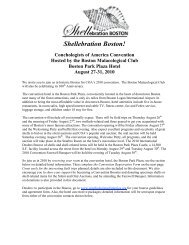download PDF - Conchologists of America
download PDF - Conchologists of America
download PDF - Conchologists of America
Create successful ePaper yourself
Turn your PDF publications into a flip-book with our unique Google optimized e-Paper software.
Page 28 Vol. 39, No. 1<br />
2010 PHILADELPHIA SHELL SHOW<br />
Supper guest speaker<br />
Dr. Henry Augustus Pilsbry<br />
On The History <strong>of</strong> Zoological Nomenclature<br />
HENRY AUGUSTUS PILSBRY (1862-1957) ranks among the<br />
most productive malacologists <strong>of</strong> all time, and described more new taxa<br />
than anyone else. He spent his entire pr<strong>of</strong>essional career at the Academy<br />
<strong>of</strong> Natural Sciences in Philadelphia, starting in 1887 as an assistant to the<br />
head <strong>of</strong> the Conchological Section, George W. Tryon. Besides his work<br />
with mollusks, Pilsbry published on Crustacea and was an acknowledged<br />
authority on barnacles. During the first four decades <strong>of</strong> his career he undertook<br />
simultaneously to continue the publication <strong>of</strong> Tryon’s vast Manual <strong>of</strong><br />
Conchology, while founding and serving the journal Nautilus in the roles<br />
<strong>of</strong> editor, publisher and major contributor and producing several books, including<br />
the Catalogue <strong>of</strong> the Marine Mollusks <strong>of</strong> Japan (1895). Pilsbry<br />
became Curator <strong>of</strong> Mollusks and Pr<strong>of</strong>essor <strong>of</strong> Malacology, and continued<br />
to research and publish until days before his death in 1957. Among his best<br />
known works is the four-volume Land Mollusca <strong>of</strong> North <strong>America</strong> (1939-<br />
48), which remains in general use today.<br />
Pilsbry gave lectures on Malacology at the Academy, and at least<br />
one <strong>of</strong> them was preserved using a Wire Recorder. This now vanished technology<br />
transferred sound by a magnetic analog process onto a steel wire as<br />
thin as a hair. The wire ran past the recording head at a rate <strong>of</strong> two feet per<br />
second, which meant that a length <strong>of</strong> roughly 1.4 miles was required for a<br />
one-hour recording. So fine was the wire, however, that even this length<br />
would fit onto a drum six inches in diameter. Wire recorders were popular<br />
for home recording in the late 1940s and early 1950s but were displaced by<br />
audio tape, which <strong>of</strong>fered higher fidelity and stereo capability. The durable,<br />
fire-pro<strong>of</strong> steel medium nevertheless lived on into the 1970s in aviation<br />
flight recorders.<br />
The sound quality <strong>of</strong> the Pilsbry wire is remarkably good, given<br />
its age. He occasionally strayed away from the microphone and thus became<br />
less audible, but his clear delivery and an impressive command <strong>of</strong><br />
English make him very easy to comprehend. A transcript <strong>of</strong> the full talk<br />
follows. Where a passage is marked […], it is not clear enough to determine<br />
the words. Otherwise, the punctuation used here is deduced from Pilsbry’s<br />
grammar. There is a brief introduction at the beginning <strong>of</strong> the recording, but<br />
who the female speaker is has not been determined.<br />
In a notable passage, Pilsbry asserts that the fossil record shows<br />
the evolution <strong>of</strong> species to occur in steps, rather than as a continuous<br />
process. This notion would later form the basis <strong>of</strong> the theory<br />
<strong>of</strong> “punctuated equilibrium” advanced by Niles Eldredge and Stephen<br />
Jay Gould in 1972, building on earlier work by Ernst Mayr<br />
at Harvard and I. Michael Lerner at Berkeley. Pilsbry had clearly<br />
reached similar conclusions somewhat earlier.<br />
Acknowledgments<br />
Assistance with arranging the digitization <strong>of</strong> the original wire was<br />
provided by Clare Flemming <strong>of</strong> the Academy Archives, where the<br />
wire and another like it are now stored. Dr. Gary Rosenberg kindly<br />
reviewed the transcription and elucidated many <strong>of</strong> the ambiguous<br />
passages and obscure references. Digitization was by Avocado<br />
Productions <strong>of</strong> Broomfield, CO. Post-editing, initial transcription<br />
and preparation <strong>of</strong> this publication were by Paul Callomon.<br />
(Above) Henry Augustus Pilsbry and staff (early<br />
to mid 1900s).<br />
(Below) The spool <strong>of</strong> wire used to record Dr. Pilsbry’s<br />
talk.




